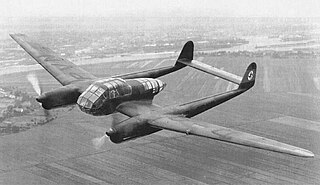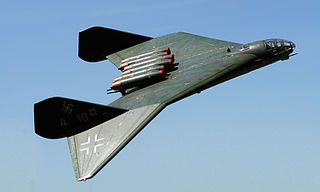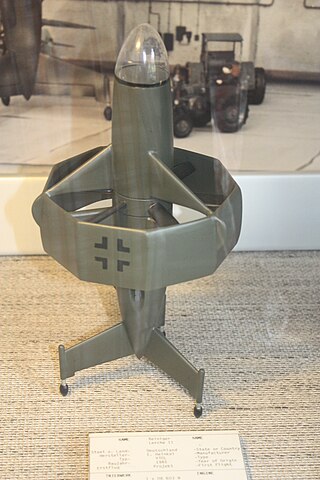Related Research Articles

The Junkers Ju 388Störtebeker is a World War II German Luftwaffe multi-role aircraft based on the Ju 88 airframe by way of the Ju 188. It differed from its predecessors in being intended for high altitude operation, with design features such as a pressurized cockpit for its crew. The Ju 388 was introduced very late in the war, and production problems along with the deteriorating war conditions meant that few were built.

The Focke-Wulf Fw 187 Falke ("Falcon") was a German aircraft designed in 1935. It was conceived by Kurt Tank as a twin-engine, high-performance fighter, but the Luftwaffe saw no role for the design, perceiving it as intermediate between the Messerschmitt Bf 109 and Bf 110. Later prototypes were adapted to two-seats to compete with the Bf 110 in the heavy fighter (Zerstörer) role, but only nine aircraft were built in total.

The Focke-Wulf Fw 58 Weihe (Harrier) was a twin-engine multi-role aircraft designed and produced by the German aircraft manufacturer Focke-Wulf.

The Focke-Wulf Fw 189 Uhu (Owl) is a twin-engine twin-boom tactical reconnaissance and army cooperation aircraft designed and produced by the German aircraft manufacturer Focke-Wulf. It was one of the Luftwaffe's most prominent short range reconnaissance platforms during the Second World War.

The Messerschmitt Me 264 was a long-range strategic bomber developed during World War II for the German Luftwaffe as its main strategic bomber. The design was later selected as Messerschmitt's competitor in the Reichsluftfahrtministerium's Amerikabomber programme, for a strategic bomber capable of attacking New York City from bases in France or the Azores.

The BMW 803 was a German aircraft engine, an attempt by BMW to build a high-output aircraft engine by coupling two BMW 801 engines back-to-back, driving contra-rotating propellers. The result was a 28-cylinder, four-row radial engine, each comprising a multiple-bank in-line engine with two cylinders in each bank, which, due to cooling concerns, were liquid cooled.

The Arado E.555 was a long range strategic bomber proposed by the German Arado company during World War II in response to the RLM's Amerikabomber project. The E.555 designation was applied to a series of long range jet bomber designs of various sizes, powerplant, crew and weapon load configurations. As design studies only, no aircraft were developed or constructed and the entire E.555 project was cancelled at the end of 1944.

The Henschel Hs 130 was a German high-altitude reconnaissance and bomber aircraft developed in World War II. It suffered from various mechanical faults and was never used operationally, only existing as prototype airframes.

The Dornier Do 317 was a prototype German medium bomber of World War II.

The Henschel Hs 124 was Henschel's entry into the Luftwaffe's twin-engine Kampfzerstörer requirement, but was abandoned after this programme was split into separate Zerstörer and Schnellbomber requirements. Three prototypes were planned, but only two were built

The Focke-Wulf Fw 42 was a design for a twin-engined medium bomber, of canard configuration, that was designed by Focke-Wulf Flugzeugbau AG in Germany in the early 1930s. Several air forces expressed interest in the aircraft. However, despite its advanced design being proven sound in wind tunnel testing, the Fw 42 failed to win a contract for development, and no examples of the type were ever built.

The Heinkel Lerche was the name of a set of project studies made by German aircraft designer Heinkel in 1944 and 1945 for a VTOL fighter and ground-attack aircraft.

The Heinkel He 72 Kadett (Cadet) was a German single-engine biplane trainer of the 1930s. It was known to its pilots as the Zitterrochen as it shook madly.

The Focke-Wulf Fw 56 Stösser was a single-engine parasol wing monoplane advanced trainer designed and built by the German aircraft manufacturer Focke-Wulf. It was the company's first aircraft to be designed from the onset by the aeronautical engineer Kurt Tank, who also named the type.
The Focke-Wulf Project I was a design study for a jet fighter, to be built in Germany during World War II. In 1942, the Reichsluftministerium (RLM) asked Professor Kurt Tank of the Focke-Wulf factory to investigate the possibility of a single-engine jet fighter. He was given the development plans of the BMW 003, Jumo 004 and Heinkel HeS 011 engines. Late in 1942 the Project Office, led by Ludwig Mittelhuber, began to work on a series of fighter projects, to be powered by one of these new turbojet units.

The Heinkel HD 42 50, later designated the Heinkel He 42 was a German two-seat biplane seaplane originally designed for the Deutsche Verkehrsfliegerschule, and later built for the German Luftwaffe. The aircraft was used until the end of World War II as a trainer for maritime pilots.

The Heinkel He 49 was a German single-bay, single-seat biplane of mixed construction armed with two machine guns. Four variants were made, the He 49a, He 49b, He 49c and He 49d.

The Focke-Wulf Fw 62 was a reconnaissance floatplane, designed and built by Focke-Wulf for use by Nazi Germany's Kriegsmarine. Only four were built.
The Gotha Go 241 was a low-wing twin-engined four-seat transport aircraft manufactured by Gothaer Waggonfabrik in the early 1940s and intended for the general aviation market.
References
- ↑ Sharp, Dan. (2016) Luftwaffe: Secret Bombers of the Third Reich. Mortons.
- ↑ Nowarra, Heinz J. (1993). Die Deutsche Luftrüstung 1933–1945 Vol.2 – Flugzeugtypen Erla-Heinkel (in German). Koblenz: Bernard & Graefe Verlag. pp. 104–105, 266–267. ISBN 3-7637-5464-4.